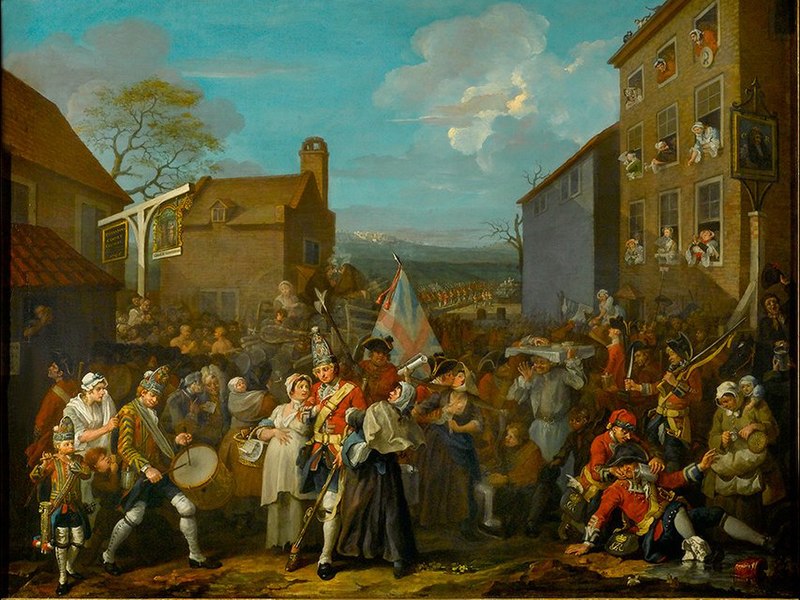 |
| William Hogarth, The March of the Guards to Finchley, c.1759, Foundling Museum, London |
The mouthful of a title, Hogarth's Britons: Succession, Patriotism
and the Jacobite Rebellion, suggests
an admirable level of ambition from the curators at Derby. I'm not sure they
achieve their aims, but this is nevertheless a thoroughly enjoyable romp of a
show. The exhibition never really decides whether it is a gallery survey of
Hogarth's art or a museum exploration of the Jacobite rebellions. One the one
hand we have cardboard cutouts of soldiers, a Jacobite garter and other
memorabilia; one the other we have random examples of Hogarth's work, like
his Election series prints and Marriage a la
Mode loaned from the National Gallery. The Jacobite Rebellions
are certainly worth an exhibition. There is local interest, certainly, with
Derby having the dubious honour of being the southern-most town the Scottish
troops reached in 1745. More importantly, the period is generally not well
covered, and, unless you are a fan of the time-travelling drama Outlander,
much of the information presented here is probably new and definitely
interesting. The question is whether the art on display really fits the
narrative.
William Hogarth is a slippery character at the best of times. Last year the Tate failed to make the case that he was at heart a European in a huge exhibition which, if you took away the captions, was really a retrospective of his whole career. In Derby, we are presented with exactly the opposite argument: Hogarth as the patriot. Well, yes and no. Hogarth was gleefully anti-French but his caricaturist's eye gleefully attacked a lot of things, including the English establishment. Derby's other great coup, a loan of The March of the Guards to Finchley (1750) from the Foundling Museum, shows the English army going to give battle to the Jacobites in 1745, but the troops are represented in a fairly disreputable light. Although the background shows them as a disciplined, martialled force, the foreground focus is on drunkenness, debauchery and disease: certainly George II found nothing to recommend it. In the end Hogarth sent it to the King of Prussia.
Allan Ramsay, Charles
Edward Stuart, c.1745, National Galleries of Scotland
Paradoxically, whilst the curators
are keen to present Hogarth as a patriot, they are more reluctant to see Allan
Ramsay as a Jacobite sympathiser, despite his newly discovered portrait of
Charles Edward Stuart and his famous image of Flora Macdonald. Ultimately
perhaps neither artist was highly politicised: both sought royal patronage (of
any kind) and were arguably more concerned with furthering their own careers
than with pursuing nationalist agendas. In the same way, the exhibition is
perhaps best viewed not through a historical lens, but as a collection of fine
mid-eighteenth century art. Ramsay is a portraitist of understated skill and
delicacy, who too often gets ignored in the Gainsborough-Reynolds duopoly.
Hogarth is fresh no matter how many times you see his work and Marriage
a la Mode is beautifully displayed here, at a perfect height and
lighting to take in all the tiny subtleties.
Derby Museum and Art Gallery is
worth a visit any time for their wonderful collection of Joseph Wrights and it
has the warm, embracing feel of a place which is valued and has had money spent
on it. There's a new entrance, built in the 1960s but recently refurbished, a lovely cafe and Objects of Hope, Love and
Fear, a sympathetically but lightly curated display of world objects.
Sadly, taking a wrong turn on the ways to the toilets, I discovered the old
entrance, chilly, empty and neglected and a locked display of
Victorian-labelled objects, which had clearly suffered water damage. Some use surely could
be found for these areas.



No comments:
Post a Comment